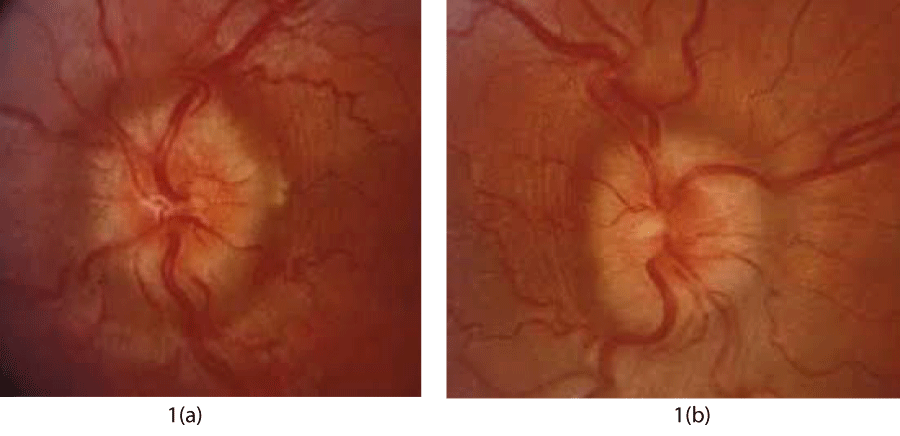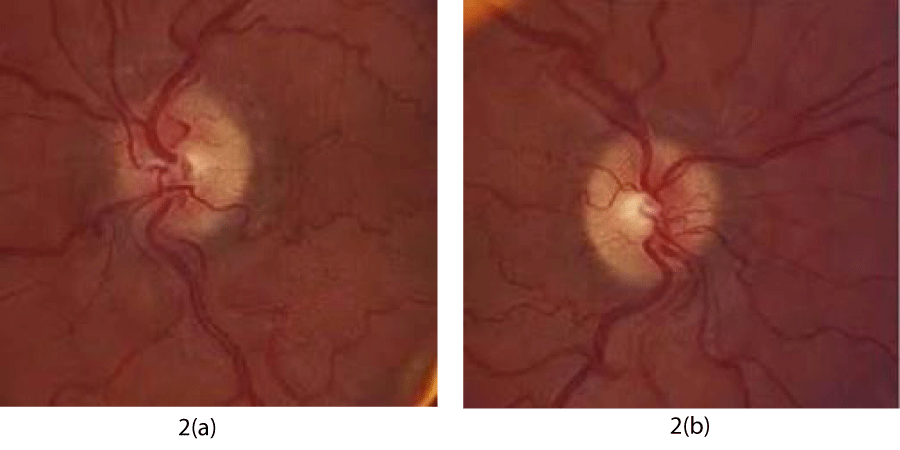Journal of Clinical Research and Ophthalmology
Systemic steroids in pediatric pseudotumor cerebri - A case report
Shruthi K*
Cite this as
Shruthi K (2024) Systemic steroids in pediatric pseudotumor cerebri - A case report. J Clin Res Ophthalmol 11(1): 008-010. DOI: 10.17352/2455-1414.000104Copyright License
© 2024 Shruthi K. This is an open-access article distributed under the terms of the Creative Commons Attribution License, which permits unrestricted use, distribution, and reproduction in any medium, provided the original author and source are credited.Study design: Case report.
Purpose: To study the efficacy of systemic steroids in pediatric pseudotumor cerebri.
Introduction: Pseudotumor cerebri is a condition caused by elevated intracranial pressure presenting most commonly with headache. It is a diagnosis of exclusion.
Methods: A 15-year-old girl presented in our outpatient department with a headache for 3 months, more in the posterior aspect, continuous type with severe intensity, non-radiating. On examination, the best corrected visual acuity in her right eye was 6/9, and her left eye was 6/6 parts. She had a normal anterior segment and normal Intraocular Pressure (IOP). Fundoscopy showed both optic discs edematous, pink in color with blurry disc margins, tortuous disc vessels, and edematous peripapillary area. The rest of the retina was normal. Lumbar puncture showed elevated opening CSF pressure and normal CSF composition. Hence she was diagnosed with IIH. She was started on oral prednisolone 1mg/kgbw once a day dosage, oral acetazolamide 250 mg once a day, topical nepafenac 0.1% one drop thrice a day and timolol 0.5% eye drops twice a day.
Discussion: The main goals of treatment are alleviation of symptoms, including headache, and preservation of vision. Steroids were commonly used for treating IIH in the past, but cause significant long-term side effects, such as weight gain, that are undesirable in IIH patients. Furthermore, withdrawal of steroids can cause rebound intracranial hypertension. Thus, steroids should not be used routinely for IIH treatment.
Results: By the end of one month, the patient was relieved of symptoms, best corrected visual acuity was 6/6 in both eyes with normal IOP, normal optic disc in both eyes.
Conclusion: Steroids are an effective way of managing idiopathic intracranial hypertension in pediatric patients.
Introduction
Idiopathic intracranial hypertension (IIH, pseudotumor cerebri) is a syndrome of elevated intracranial pressure of unknown cause that occurs predominantly in obese women of childbearing age. It is a diagnosis of exclusion and, therefore, other causes of increased intracranial pressure must be sought with history, imaging, and cerebrospinal fluid examination before the diagnosis can be made. Headache is the most common symptom reported by IIH patients at presentations [1,2].
Case report
A 15-year-old girl presented in our OPD at Manjunatha Eye Hospital, Kundapura, Udupi with a headache for 3 months, more in the posterior aspect, continuous type with severe intensity, non-radiating. On examination, the best corrected visual acuity in her right eye was 6/9, and her left eye was 6/6 parts. She had a normal anterior segment and normal intraocular pressure in both eyes. Fundus examination showed both optic discs edematous, pink in color with blurry disc margins, tortuous disc vessels, and edematous peripapillary area. Normal foveolar reflex with the normal retinal periphery (Figure 1a,b).
The patient had been evaluated in a tertiary care hospital and her blood reports were normal. Neurological evaluation was also done and a lumbar puncture showed high opening pressure of CSF with normal CSF composition. Hence pseudotumor cerebri was diagnosed. She was using oral acetazolamide 250 mg three times a day for a period of one month which showed no improvement.
She was started on oral prednisolone 1 mg/kgbw once a day dosage, oral acetazolamide 250 mg once a day, topical nepafenac 0.1% one drop thrice a day and timolol 0.5% eye drops twice a day for a period of 2weeks. On follow-up, the patient was relieved of symptoms, and disc edema was also reduced in the next visit. Later her oral prednisolone was tapered on a weekly basis and the rest of the medications were continued.
By the end of one month, the patient was relieved of symptoms, the best corrected visual acuity was 6/6 in both eyes with normal IOP, and the left optic disc was normal with regular well-defined margins and normal vessels. The right optic disc was mildly edematous with ill-defined nasal margins and the rest of the margins were well defined. The patient was advised to continue oral prednisolone in weekly tapering doses with topical anti-inflammatory and anti-glaucoma agents. By the end of 2 months, the patient was completely fine with normal vision and a normal optic disc with well-defined margins (Figure 2a,b). She was followed up for a period of 12 months on a 2-monthly basis and was found to maintain a normal state.
Informed consent has been taken from the patient and the patient’s mother.
Discussion
The main goals of treatment are alleviation of symptoms, including headache, and preservation of vision [3]. Steroids were commonly used for treating IIH in the past, but cause significant long-term side effects, such as weight gain, that are undesirable in IIH patients. Furthermore, withdrawal of steroids can cause rebound intracranial hypertension [4,5]. Thus, steroids should not be used routinely for IIH treatment. High-dose intravenous steroids can, however, be useful for short-term treatment of patients with fulminant disease while a more definitive intervention (e.g., optic nerve sheath fenestration or cerebrospinal fluid shunting) is awaited [6-10]. There are other studies supporting the safe use of acetazolamide up to 4 g daily with weight loss for effective treatment of mild vision loss in IIH, with associated improvements in papilledema, increased intracranial pressure, and quality of life [8-15].
In our study, the patient was already on acetazolamide for a long duration but did not show any signs of improvement in symptoms or disc edema.
Conclusion
Steroids are an effective way of management of idiopathic intracranial hypertension in pediatric patients not responding to acetazolamide single therapy. This also avoids the risk of surgical intervention in pediatric patients.
- Wall M, George D. Idiopathic intracranial hypertension. A prospective study of 50 patients. Brain. 1991 Feb;114 ( Pt 1A):155-80. PMID: 1998880.
- Giuseffi V, Wall M, Siegel PZ, Rojas PB. Symptoms and disease associations in idiopathic intracranial hypertension (pseudotumor cerebri): a case-control study. Neurology. 1991 Feb;41(2 ( Pt 1)):239-44. doi: 10.1212/wnl.41.2_part_1.239. PMID: 1992368.
- Thurtell MJ, Wall M. Idiopathic intracranial hypertension (pseudotumor cerebri): recognition, treatment, and ongoing management. Curr Treat Options Neurol. 2013 Feb;15(1):1-12. doi: 10.1007/s11940-012-0207-4. PMID: 23136035; PMCID: PMC3554852.
- Liu GT, Kay MD, Bienfang DC, Schatz NJ. Pseudotumor cerebri associated with corticosteroid withdrawal in inflammatory bowel disease. Am J Ophthalmol. 1994 Mar 15;117(3):352-7. doi: 10.1016/s0002-9394(14)73145-9. PMID: 8129010.
- Neville BG, Wilson J. Benign intracranial hypertension following corticosteroid withdrawal in childhood. Br Med J. 1970 Sep 5;3(5722):554-6. doi: 10.1136/bmj.3.5722.554. PMID: 4318283; PMCID: PMC1701594.
- Thambisetty M, Lavin PJ, Newman NJ, Biousse V. Fulminant idiopathic intracranial hypertension. Neurology. 2007 Jan 16;68(3):229-32. doi: 10.1212/01.wnl.0000251312.19452.ec. PMID: 17224579.
- Liu GT, Glaser JS, Schatz NJ. High-dose methylprednisolone and acetazolamide for visual loss in pseudotumor cerebri. Am J Ophthalmol. 1994 Jul 15;118(1):88-96. doi: 10.1016/s0002-9394(14)72847-8. PMID: 8023881.
- Smith SV, Friedman DI. The Idiopathic Intracranial Hypertension Treatment Trial: A Review of the Outcomes. Headache. 2017 Sep;57(8):1303-1310. doi: 10.1111/head.13144. Epub 2017 Jul 30. Erratum in: Headache. 2018 Nov;58(10):1697. PMID: 28758206.
- Wall M, Johnson CA, Cello KE, Zamba KD, McDermott MP, Keltner JL; NORDIC Idiopathic Intracranial Hypertension Study Group. Visual Field Outcomes for the Idiopathic Intracranial Hypertension Treatment Trial (IIHTT). Invest Ophthalmol Vis Sci. 2016 Mar;57(3):805-12. doi: 10.1167/iovs.15-18626. PMID: 26934136; PMCID: PMC4777274.
- Spitze A, Malik A, Al-Zubidi N, Golnik K, Lee AG. Optic nerve sheath fenestration vs cerebrospinal diversion procedures: what is the preferred surgical procedure for the treatment of idiopathic intracranial hypertension failing maximum medical therapy? J Neuroophthalmol. 2013 Jun;33(2):183-8. doi: 10.1097/WNO.0b013e318292d06f. PMID: 23681243.
- Wall M, Kupersmith MJ, Kieburtz KD, Corbett JJ, Feldon SE, Friedman DI, Katz DM, Keltner JL, Schron EB, McDermott MP; NORDIC Idiopathic Intracranial Hypertension Study Group. The idiopathic intracranial hypertension treatment trial: clinical profile at baseline. JAMA Neurol. 2014 Jun;71(6):693-701. doi: 10.1001/jamaneurol.2014.133. PMID: 24756302; PMCID: PMC4351808.
- Mollan SP, Davies B, Silver NC, Shaw S, Mallucci CL, Wakerley BR, Krishnan A, Chavda SV, Ramalingam S, Edwards J, Hemmings K, Williamson M, Burdon MA, Hassan-Smith G, Digre K, Liu GT, Jensen RH, Sinclair AJ. Idiopathic intracranial hypertension: consensus guidelines on management. J Neurol Neurosurg Psychiatry. 2018 Oct;89(10):1088-1100. doi: 10.1136/jnnp-2017-317440. Epub 2018 Jun 14. PMID: 29903905; PMCID: PMC6166610.
- Markey KA, Mollan SP, Jensen RH, Sinclair AJ. Understanding idiopathic intracranial hypertension: mechanisms, management, and future directions. Lancet Neurol. 2016 Jan;15(1):78-91. doi: 10.1016/S1474-4422(15)00298-7. Epub 2015 Dec 8. PMID: 26700907.
- Degnan AJ, Levy LM. Pseudotumor cerebri: brief review of clinical syndrome and imaging findings. AJNR Am J Neuroradiol. 2011 Dec;32(11):1986-93. doi: 10.3174/ajnr.A2404. Epub 2011 Jun 16. PMID: 21680652; PMCID: PMC7964411.
- Yri HM, Rönnbäck C, Wegener M, Hamann S, Jensen RH. The course of headache in idiopathic intracranial hypertension: a 12-month prospective follow-up study. Eur J Neurol. 2014 Dec;21(12):1458-64. doi: 10.1111/ene.12512. Epub 2014 Jul 29. PMID: 25070715.

Article Alerts
Subscribe to our articles alerts and stay tuned.
 This work is licensed under a Creative Commons Attribution 4.0 International License.
This work is licensed under a Creative Commons Attribution 4.0 International License.



 Save to Mendeley
Save to Mendeley
